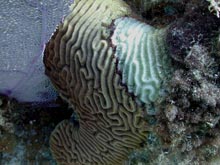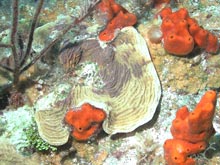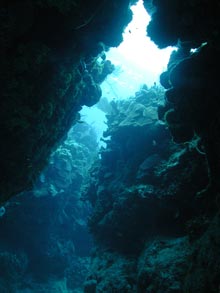This lettuce coral (Agaricia sp.) is one of the most common corals on the reefs of Little Cayman. The natural color is light tan, but this colony has dark pigmented areas commonly known as dark spot syndrome. The coral is nestled among bright orange sponges (Ectyoplasia ferox). Click image for larger view and image credit.
At the edge of the drop-off we find a diversity of sponges and hard and soft corals. Two big barrel sponges (Xestospongia muta) are perched on the slope. Click image for larger view and image credit.
Coral Stress and Connectivity to the Deep Reef
May 21, 2007
Deb Gochfeld
University of Mississippi
Julie Olson
University of Alabama
Michael Lesser
University of New Hampshire
Marc Slattery
University of Mississippi
Global climate change and human-related activities have resulted in a variety of coral stress-specific outcomes, including bleaching and disease. One of NOAA’s priorities is to protect, restore, and manage coastal and ocean resources. Approximately 70% of the world’s reefs have been destroyed or are considered threatened by human activities. Reefs in the Caribbean are under particular stress due to increases in coastal populations, which have resulted in an 80% decline in coral cover over the past 25 years. Although the risks to shallow reefs are increasing, we have no information to date regarding the incidence of coral diseases on deep-reef communities. Since deep reefs are less likely to experience dramatic environmental fluctuations (such as temperature, salinity, and pollution) than shallow reefs, they may act as a refuge from stress and diseases associated with poor environmental conditions. Additionally, the difficulty of studying deep reefs means they have rarely been visited, and we know virtually nothing about the health of the organisms that live there. One of the major scientific questions for our survey of the Cayman Islands Twilight Zone is: what is the incidence of disease on deep coral reefs, and are they more or less diseased than their shallow-water relatives? In preparation for these surveys of deep reefs, we conducted 12 shallow-reef surveys on nearby sites earlier this week for comparison.
Coral surveys are conducted by divers swimming over a “transect” that consists of a line placed on the sea bottom at a specific depth over which many photographs of the reef are taken. Multiple transects are conducted to increase the accuracy of our biodiversity estimates, and each species encountered along these transects are also assessed for health condition. In general, the corals of the shallow reefs on Little Cayman Island are fairly healthy compared to other sites we have surveyed in the Caribbean. However, there are a few syndromes that appear to be more common than at many other Caribbean sites.
Over the course of the next two weeks ,the Twilight Zone dive team will work to progressively deeper depths to assess disease incidence. At major depth contours (150 feet, 200 ft, 250 ft, and 300 ft), the divers will conduct transects in a similar way to those carried out for the shallow-reef survey transects. Digital video and photos will be used to identify species, and samples will be collected for further analyses. The biodiversity, abundance, and health of these samples will be compared to the data generated on the shallow sites over the last week. This information will help answer our questions regarding the health of the deep reefs, and in doing so will provide new and fundamental insights into deep reef community dynamics and connectivity to shallow coral reefs.

Black band disease was one of the first coral diseases identified back in the 1970s, and it is still one of the most prevalent diseases on reefs worldwide. The disease forms a black band of microorganisms that progresses across the coral surface, leaving dead white skeleton behind, as evidenced on this brain coral (Diploria strigosa). Click image for larger view and image credit.

This blushing star coral (Stephanocoenia mechelinii) is severely affected by dark spot syndrome. Although this syndrome rarely kills corals, it can cause localized mortality of coral tissues, as seen in the center of this colony. Click image for larger view and image credit.






















